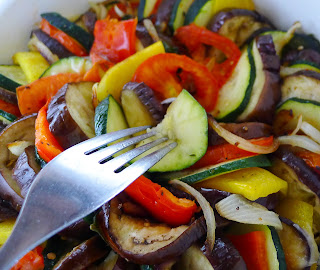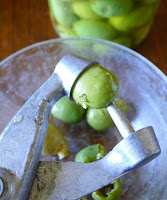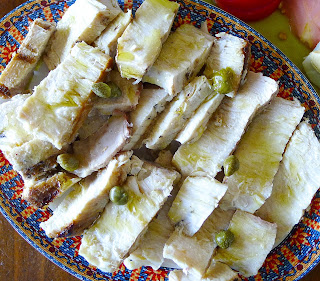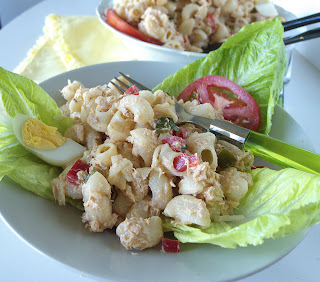 |
| Looks like a gratin, no? Summer vegetables cooked in the microwave are topped with cheese and crispy breadcrumbs. No oven needed. |
Would you turn on the oven to make a summer vegetable gratin? That was a question posed in one of my food groups on Facebook. My answer: NO WAY. I don’t turn on the oven from the first of June until mid-September. That’s been the house rule for years. But now, with heat waves coming earlier and more severe (we hit 40ºC/104ºF a few days ago), we will have to extend the oven ban from May until October. Scary.
If using the oven is out of the question, how to cook in the summer? I long ago stopped making baked goods, so that’s no problem. But I miss a weekly roast chicken, a simple preparation that’s good the first time round, with leftovers to last a few days. And, yes, I remember making summer vegetable gratins. How to adapt?
Andalusians have traditionally not used ovens at all. No roasts nor oven casseroles. So summer fare just means faster top-of-the-stove cooking—fried fish and gazpacho being a perfect summer meal. In the old days, paella cooked, on a wood fire, nowadays it’s still cooked outdoors, on a gas ring big enough for a huge paella pan. Fat bell peppers are roasted on the parilla, wood-fired grill, or else purchased with fresh bread at the village panadería, where the peppers are roasted in bread ovens.
At my house, I have adapted the roast chicken for the gas grill on the patio. And, the gratin, while not legally gratinée, works pretty well in the microwave.
 |
| My summer substitute for oven-roasted chicken. Small, spatchcocked chickens are quick to cook on a grill. |
 |
| Leftover grilled chicken makes a great summer salad with cheese and tangy olives. |
Microwave Summer Vegetables with Crumb Topping
Verduras al Microonda con Crujiente de Migas
I make a quite acceptable eggplant Parmesan in the microwave, after first frying the slices of eggplant in a skillet. This is different in that all the vegetables are layered raw. They never become totally soft as with an oven-baked casserole, but keep their texture very nicely. I’ve added the crunchy bread crumbs after removing the vegetables from the microwave.
A ceramic tian casserole is perfect for this dish, as long as it fits inside your microwave unit. A deep-dish glass pie pan is a good alternative as is an earthenware cazuela or any round, flat-bottomed bowl with straight sides. Presumably, microwave-safe plastic would work, although I didn’t try it.
 |
| Slice vegetables. |
The vegetables need to be cut in fairly equal ¼-inch slices. Salt the eggplant slices and let them stand in a colander 15 minutes so they release excess liquid. Slice the tomatoes, salt them lightly and lay on a plate. When assembling, lift them and discard the liquid.
I used a vegetable peeler to peel the bell peppers.
You can use more or less of the listed vegetables or swap others. If you use sliced potatoes, sweet potatoes, carrots or butternut squash, steam or parboil them before layering with the other vegetables.
Serve the vegetables hot, room temperature or cold. Sprinkle with the crispy crumbs right before serving. Cold, the vegetables are good with a squeeze of lemon.
Serves 4-6.
For the crumb topping:
3 slices day-old bread (5 ounces), crusts removed
3 tablespoons olive oil
1 clove garlic, chopped
Pinch of dried thyme or parsley
For the vegetables:
Olive oil
1 cup reserved crumbs
1 onion
2-3 medium eggplant (1 pound)
3 plum tomatoes
1 medium zucchini and/or yellow squash (12 ounces)
2 bell peppers, yellow and/or red
Salt
Freshly ground black pepper
Basil leaves, torn
1 ounce thinly sliced cheese
2 ounces grated cheese
 |
| Crispy bread crumbs. |
Tear the bread into pieces. Use a food processor to chop it into coarse crumbs. You should have about 2 ½ cups crumbs.
Reserve 1 cup of the crumbs to layer with the vegetables.
Heat the oil in a skillet. Add the remaining 1 ½ cups of crumbs and fry them until they begin to turn golden. Add the chopped garlic and continue to fry until crumbs are browned and crispy. Stir in thyme. Remove crumbs from the skillet.
Oil a microwave-safe dish. Spread the reserved 1 cup of crumbs that were not fried in the bottom of the dish.
Heat 1 tablespoon of oil in a skillet. Cut the onion in thin julienne slices. Sauté until they are softened and beginning to brown, 4 minutes. Remove from the heat. Spread half of the onions in the bottom of the dish on top of the crumbs.
Slice the eggplant crosswise into rounds. If eggplant is very large, cut the slices in half. Salt them lightly and leave 15 minutes in a colander to drain. Pat them dry with a paper towel. Slice the tomatoes crosswise. Salt them lightly and lay flat on a plate.
 |
| Overlap sliced vegetables in dish. |
Slice the zucchini, peppers and any other vegetables selected into more-or-less equal-sized pieces. Sprinkle with salt and pepper.
Arrange the eggplant, tomato, zucchini and pepper slices in overlapping rows in the dish. Push slices of the sautéed onion and sliced cheese between the sliced vegetables. Tuck pieces of basil between the vegetables. When all of the vegetable slices have been incorporated, drizzle 2 tablespoons of oil over the top.
 |
| Test vegetables for doneness. |
Cover the dish with plastic wrap or a microwave plastic lid. Microwave on High for 5 minutes. Microwave on Medium-High until vegetables are done to taste, about 15 minutes. The heavy dish will be very hot, so use oven mitts or a towel to protect hands when removing the dish.
Remove the lid or plastic wrap. Sprinkle the grated cheese on the top of the vegetables. Return the dish to the microwave uncovered. Microwave on Medium-High for 5 minutes. Leave the dish in the microwave for at least 5 minutes.
Before serving, sprinkle the top with the crispy crumbs.
Grilled Chicken
Pollo a la Parilla
 |
| Two-pound chickens |
These supermarket chickens come two to a package, each weighing only 2 pounds. Once spatchcocked and opened flat, they cook very quickly on the grill (40 minutes or so). “Dry brining” helps to keep them juicy.
Try different spice blends. I’m currently experimenting with Middle Eastern za’atar, a mixture of thyme, oregano, sumac and sesame seeds. Other mixes to try: Spanish pinchito spice, Moroccan ras el hanout, Indian garam masala. Or make up your own.
2 small (2-pound) chickens
Salt
Freshly ground black pepper
Olive oil
Spice-herb blend such as za’atar
Lemon juice
Spatchcock (butterfly) the chickens by cutting out and removing the back bone, opening the chicken out and pressing the breastbone to flatten it. Sprinkle the chickens on both sides with salt and pepper. Leave them, uncovered, in the refrigerator for up to eight hours.
Before grilling, brush the chickens with oil. Sprinkle them with the spice-herb mixture and squeeze lemon juice over them.
Preheat grill. Grill the chickens, bony-side down, over indirect heat for about 30 minutes. Douse any flare-ups and adjust the position of the chickens so they don’t burn. Turn them skin-side down. Grill until golden-brown and done in the thickest part. (Test by cutting into the thigh to see if juices run clear.)
Allow the chickens to rest 10 minutes before serving. Or, store refrigerated, for use in chicken salad (recipe follows).
Chicken Salad with Olives
Ensalada de Pollo con Aceitunas
 |
| Cut leftover grilled chicken into strips or cubes for the chicken salad. |
The slight sweetness of vinegar made from Málaga wine complements the vinaigrette for this chicken salad. PX vinegar would also be good. Both are mellow and less sweet than balsamic.
 |
| Trusty olive pitter! |
Serves 2 to 3.
2 cups cooked chicken, cut in strips or cubes
Salt
Freshly ground black pepper
½ cup sliced pitted green olives
¼ cup seedless black grapes
2 tablespoons diced celery
1 tablespoon diced red bell pepper
2 tablespoons finely chopped onions
2 ounces cheese, cut in strips or dice (½ cup)
1 teaspoon Dijon mustard
1 ½ tablespoons Flor de Málaga vinegar
½ teaspoon salt
¼ teaspoon pimentón de la Vera (smoked paprika)
3 tablespoons extra virgin olive oil
Salad greens to serve
Cherry tomatoes to garnish
Sprigs of fresh herbs to garnish
Place the cut-up chicken in a bowl. Season with salt and pepper. Add the olives, grapes, celery, red pepper, onions and cheese. Mix gently.
In a jar combine the mustard, vinegar, salt and pimentón. Stir well. Add the oil. Cap the jar and shake it until dressing is smooth.
Stir the dressing into the chicken and combine well. (If not serving the salad immediately, store it, covered and refrigerated.) Spread plates with salad leaves. Spoon the chicken salad on the greens. Garnish with cherry tomatoes and sprigs of fresh herbs.
More recipes for the microwave:
Another way to use the grill instead of the oven:












































